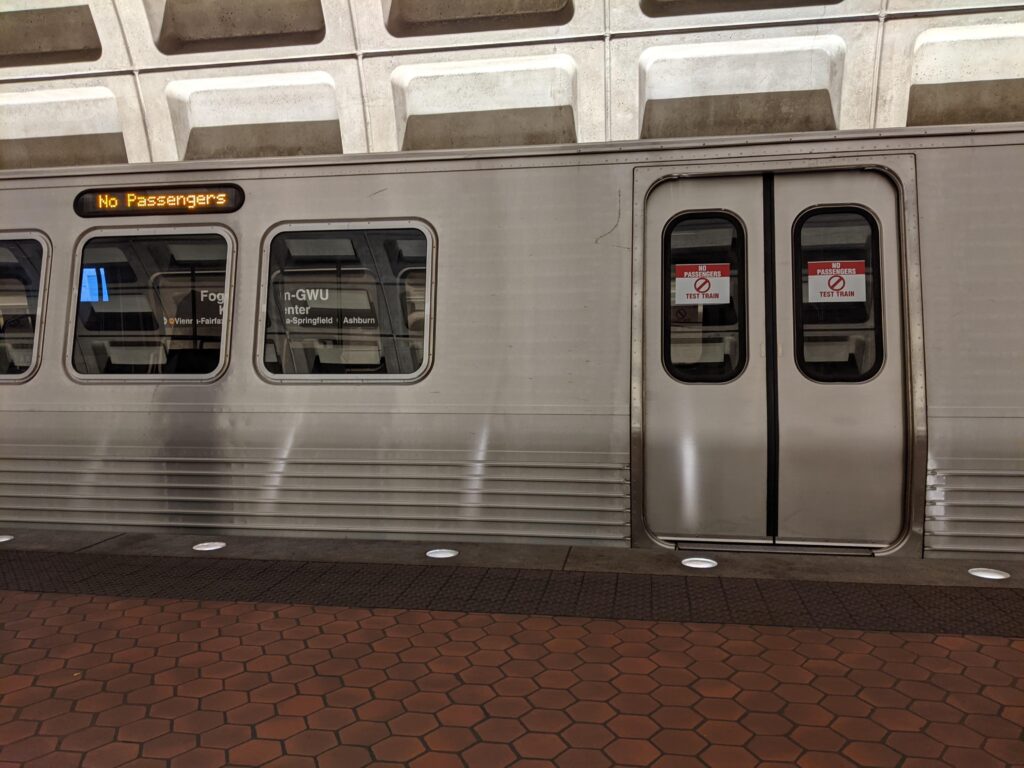Each morning before heading to a public charter school in southeast Washington, one teacher must decide if she’s going to pay for an Uber, which can be up to $40 during surges, or wait for a Metrorail train.
Liz Samball, who started teaching physical education at Excel Academy three years ago, perfected her commute routine before the pandemic. Required to be at school by 8 a.m., she rode the green line from her home in Waterfront through two metro stops before getting off at the Anacostia stop and taking a short walk to the school, located on Martin Luther King Jr. Ave SE.
She felt free to leave her house whenever she chose, knowing there an abundance of trains would come through at about 12-minute intervals. Now, however, due to delays and train reductions, Samball said she finds it nearly impossible to predict what her commute will be like each morning.
The derailment of a 7000 Series Metro car in early October led the Washington Metropolitan Area Transit Authority (WMATA) to pull all cars of that model — more than 60% of the WMATA fleet — for individual inspection. With fewer trains running, commuters are experiencing longer wait times, most notably in underserved communities.

In a city where 35% of the population relies on public transportation, many people are affected when part of that system fails. People of color and people from low-income backgrounds make up the majority of bus riders, according to WMATA data set to be presented at a board meeting on Nov. 18. With fewer trains running, there is an added demand for bus service.
As of Nov. 8, red line trains operated every 12 minutes while the green and yellow line trains went about every 20 minutes. WMATA said the orange, silver and blue lines, which go through Ward 7, are also experiencing longer wait times and are expected to arrive every 30 minutes.
With the delays and reductions in train numbers, workers must either stick out the wait or transfer to a Metrobus, said James Pizzurro, creator of the Metro Hero smartphone app.
“There has been such a traditional reliance on Metrorail as the fastest transit mode, as the transit mode that enables the most transit-oriented development,” he said.
When those systems fail is when equity issues come to light, Pizzurro said. Bus riders were already dealing with issues related to national driver shortages and delays due to traffic. Now, with train riders choosing to switch to the bus, there is more demand than the system can keep up with, Pizzurro said. Data collected by his app shows there was a 367% increase in ridership on Oct. 20.
“This is what happens when we have such an overwhelming operational focus on the rail side of things,” he said. “I think we’re seeing the fallout from that.”
WMATA has been working on a 10-year-plan to improve the bus system, stating that bus riders are typically from low-income neighborhoods. Part of the plan includes distributing bus service throughout the city so there is equal access to the bus.
Right now, many Black D.C. residents cannot afford to live within walking or biking distance of their workplace. Data from the D.C. Policy Center found that those who biked to work earned an average of $60,000 a year, while workers who took the bus earned an average of $32,000, the 2017 data found.
The difference in who was walking or biking to work versus taking the bus showed major differences among races. The same report found that in 2015, only 5,765 Black or African American workers walked to their jobs in D.C., while 29,000 whites did.

This proves to be true based on who continued to commute during the pandemic. Data from WMATA show that train ridership was down 80%-90% during the early stages of the pandemic. However, bus ridership decreased by only about 50%. Not acknowledging these commuters is a huge equity issue, said Katherine Kortum, a former chair for the WMATA riders advisory committee who now works for the Transportation Research Board.
“The idea that nobody continued to take transit during the pandemic was just rude, frankly,” She said. “It was overlooking a large population who are already overlooked in so many ways.”
The data also suggest that bus riders were continuing to go into work because their jobs could not be done virtually. Workers who rely on public transportation are more likely to be in the position of not being able to afford alternative options. Data collected by the Office of the District of Columbia Auditor show that residents in Wards 7 and 8 had the lowest number of workers doing telework during the pandemic.
Samball uses the green line, the only one with service to Ward 8, to get to work. She said she’s been having inconsistent experiences with the timing of incoming trains.
“Five minutes here or there could mean I’m on time to work or I’m 35 minutes late to work,” Samball said.
Sometimes she’ll get to the platform to see the next train won’t be coming for another 25 minutes, double the wait time she is used to. And there are few affordable alternatives available.
“A normal Uber trip would be about $12 but sometimes they were asking for $30 to $40. I was literally having to decide between paying $40 for a 10 minute trip, or waiting and being late to work,” she said.
Many other workers, however, do not even consider a $40 Uber.
Investing more money and effort into making the bus system a reliable form of transportation would be beneficial not only when the rail system fails, but as a dependable choice for commuters everyday, Pizzurro said.
He suggested this could be done by giving buses the right-of-way on roads and increasing bus frequency. Both efforts will help keep the routes on schedule, providing a dependable experience for commuters.







